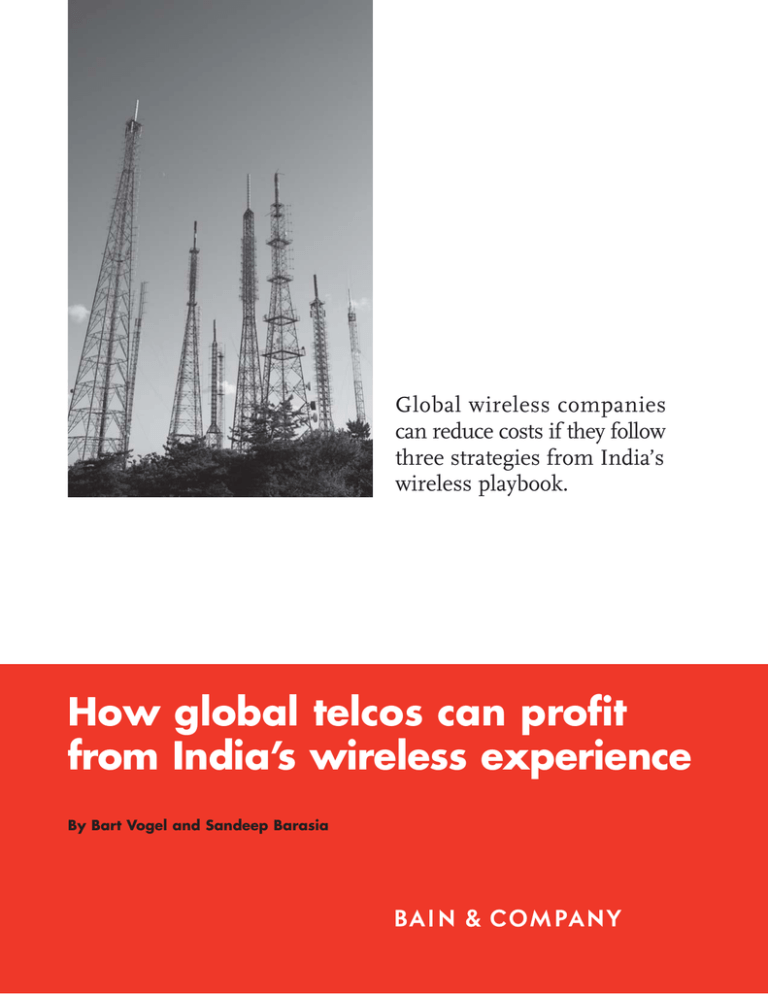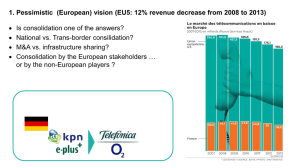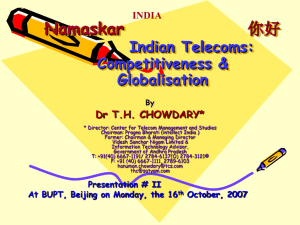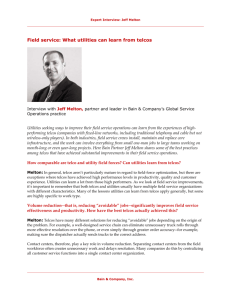
Global wireless companies
can reduce costs if they follow
three strategies from India’s
wireless playbook.
How global telcos can profit
from India’s wireless experience
By Bart Vogel and Sandeep Barasia
Bart Vogel is a partner with Bain & Company in Sydney and co-leads Bain’s AsiaPacific Telecommunications, Media & Technology practice. Sandeep Barasia is
a partner with Bain & Company in New Delhi and a member of Bain’s Global
Telecommunications, Media & Technology practice.
Copyright © 2011 Bain & Company, Inc. All rights reserved.
Content: Manjari Raman, Elaine Cummings
Layout: Global Design
How global telcos can profit from India’s wireless experience
Global wireless companies can reduce costs
if they follow three
strategies from India’s
wireless playbook.
telcos in developed countries (see Figure 1).
For example, in 2009, Indian wireless ARPU
averaged just $2.90 a month. Compare that
with about $50 a month in the US, a little over
$22 a month in Germany and nearly $58 in
Japan. Even in developing countries like Brazil
and Mexico, ARPU averages close to $13 and
$14 a month, respectively.
As many wireless telecommunications operators around the world reach saturation points
in consumer penetration, they fear hitting a
growth wall. These companies face mounting
competition, declining average revenue per
user (ARPU) and steeply rising costs. All these
factors put tremendous pressure on their margins. Increasingly, wireless companies must
hunt for ways to squeeze more from their
business model—but where and how?
Yet, Indian wireless companies excel in eking
substantial returns from thin soil. Leading
Indian players like Reliance Communications
and Bharti Airtel (Airtel) enjoy EBITDA (earnings before interest, taxes, depreciation and
amortization) margins of more than 30 percent.
These compare well with global competitors
such as AT&T, Verizon, Deutsche Telekom,
Vodafone Group and Telefónica, despite having
ARPUs of one-tenth or less of these giants
(see Figure 2). Only some of this wide variance
can be explained by scale and the relatively
lower wages of the Indian labor force. Much
more hinges on a unique business model.
To find answers they might consider dialing the
country code for India. Indian telcos continue
to thrive despite serving users at bare minimum
rates. Their ARPU is a fraction of comparable
Figure 1: Indian wireless players have less than one-tenth the ARPU of telecom companies
in developed countries
Wireless ARPU (2009, monthly)
$60 57.8
52.0
50.2
40
34.4
33.6
22.3
20
17.6
16.3
13.8
12.8
10.0
9.4
3.0
2.9
0
Japan
France
USA
UK
Korea Germany Hong Malaysia Mexico
Kong
Brazil
China
Russia Pakistan
India
Note: APRU mentioned is overall APRU (divided by 12 for monthly ARPU)
Source: Ovum (mobile regional and country forecast pack: 2010–15, May 2010)
1
How global telcos can profit from India’s wireless experience
How do India’s young telcos generate superior
returns and make calls so inexpensive for
consumers? The true secret of their success
lies in a rock-bottom cost model that aims to
achieve the most optimal economics at three
levels: First, Indian providers have learned how to
“manufacture” very low-cost minutes. Second,
they continually strive for high levels of network utilization. All this amounts to a telecom
breakthrough in achieving high minutes of use
(MOU) rates while radically de-layering traditional telco operations. Third, they have a customer acquisition and distribution model that
ignores the traditional norms created in more
mature markets. Let’s consider these factors
in detail.
Manufacturing very
low-cost minutes
India’s mammoth population of 1.17 billion
people creates a unique market, but it can
provide universal lessons. Its telcos’ huge scale
of mobile operations and integrated networks
help them achieve their high MOU totals. India
has one of the largest mobile subscriber bases
in the world. In 2010, the country had 752
million mobile subscribers, second only to
China’s 842 million—and more than double
the 305 million subscribers in the US, whose
total population is around 310 million.
India also has some of the highest minutes
of use per connection globally (see Figure 3):
nearly 4,000 MOU per year per connection
compared with nearly 2,500 in China and just
over 1,600 in Japan. India’s total annual minutes of usage are also very high at 3,000 billion
versus 1,450 billion MOUs for the US and 150
billion MOUs for Germany. One key reason for
high mobile usage: the low penetration and lack
of sophistication of fixed-line services in India
when mobile phones first arrived. Consumers
shifted their pent-up demand for communications to mobile phones. Culturally, Indian
consumers enjoy communicating frequently,
and at length, whether through conversations
or texting. Lower prices further encouraged
Figure 2: Leading Indian wireless companies are as profitable as their European and
US peers
EBITDA margins
50%
45
40
35
Verizon
AT&T
30
Vodafone
Deutsche Telekom
Telefónica
25
Telstra
Idea Cellular
20
Reliance
Bharti Airtel
0
FY03
FY04
FY05
FY06
Note: FY05 for Indian telecom players implies year ending March 2005
Source: CapIQ company reports; analyst reports
2
FY07
FY08
FY09
How global telcos can profit from India’s wireless experience
greater usage: as prices plummeted from an
average of 16 cents a minute in 1998 to just
0.70 cents a minute 10 years later, more Indians
consumed more mobile minutes.
To enable this volume, Indian telecommunications companies maintain large, integrated
networks. For instance, the top six wireless
companies in India, measured by subscriber
base, all operate across the breadth of the
country, handling more than 50 million subscribers each.
Indian telcos do this very inexpensively by two
means: sharing passive infrastructure such as
the tower, shelter or generators and the wide
use of outsourcing. That outsourcing reduces
what in the rest of the world are the high fixed
costs of such backbone items as networks,
information technology (IT) maintenance and
services, data transmission and certain areas
of general and administrative expenses. That
approach of sharing passive infrastructure helps
amortize costs among a larger set of players.
The savings then translate into lower billing
rates that still deliver strong profits.
For instance, sharing or leasing towers can
save as much as 25 percent of tower costs as
tenancy increases from one operator to more.
These savings will increase further when the
telcos begin sharing active infrastructure like
antennae, feeder cables, nodes and transmission systems, too. While active infrastructure
sharing is still at a nascent stage—most companies are still testing possibilities through
intra-circle roaming, whereby calls from one
operator use the network of another operator—
almost every telco in India is aggressively
pursuing passive sharing.
Many have teamed to spin off their passive
assets into separate entities. Tata Teleservices
sold its towers to Viom Networks (the erstwhile Quippo WTTIL). Bharti Infratel (Airtel),
Vodafone Essar and Aditya Birla Telecom Ltd.
(Idea) came together to set up a joint venture,
Indus Towers, to handle their passive assets.
Figure 3: India ranks high in minutes of use (MOU) compared with other global markets
MOUs/connection (2010)
Total MOUs (2010)
6,000
3,000B
4,000
2,000
2,000
1,000
0
India
Brazil
USA
France
Mexico
UK
Germany
Poland
Hungary
MOUs/connection
China
Australia
Japan
Hong Kong
Singapore
Korea
0
South Africa
UAE
Total MOUs
Source: Ovum (Mobile Connections Forecast Pack, May 2010; mobile regional and country forecast pack: 2010–15, May 2010)
3
How global telcos can profit from India’s wireless experience
And Reliance Infratel and GTL Infrastructure
came close to striking an $11 billion deal to
create the world’s largest independent telecom
infrastructure company. The benefit: such
initiatives not only free up capital for investments, they help reduce interest costs.
Beyond sharing passive infrastructure, Indian
telcos improve operating efficiencies by extensively outsourcing network development, operations and maintenance. Airtel works with
more than half a dozen partners—from IBM to
Ericsson—for functions such as network planning, IT and call center operations. Reliance’s
joint venture partner, Alcatel-Lucent, manages
the company’s CDMA and GSM mobile phone
networks. Vodafone partners with IBM and
Nokia on back-office IT operations and network management. Indian telcos may have
pioneered such pervasive outsourcing, but
many global players are beginning to adopt
this tactic, too. Recently Maxis, a leading player
in Malaysia, announced a new network outsourcing deal with China’s Huawei.
Thanks, too, to outsourcing, new products and
services come to market at minimal costs—
and roll out faster. Tata Teleservices, for example, recently signed a deal with Nokia Siemens
Networks to support the launch of its network
in India. In a deal worth $700 million, Airtel
similarly partnered with Nokia Siemens Networks
to roll out its networks in record time, as well
as to manage its radio and core network and
services in eight Indian telecom circles.
Pushing high levels of utilization
The success of Indian telcos hinges on matching these very low costs with very high utilization of networks (see Figure 4). The principle:
serve more with less. India’s companies typically operate their networks at full capacity
levels not seen in most other telcos. The goal
is to treat most expenses as variable costs and
track them against a minute of use. Despite
having limited spectrum compared with many
of their global peers, Indian telcos serve much
higher levels of subscribers and MOU. Indeed,
Figure 4: Indian telcos achieve very high levels of utilization, often operating well
above capacity
Capacity position by circles
(number of circles)
100%
23
23
23
80
Excess capacity
60
Near capacity
40
At capacity
Above capacity
20
Well above capacity
0
Airtel
Source: TRAI; COAI; TEC; analyst reports
4
Vodafone
Idea
How global telcos can profit from India’s wireless experience
some of the nation’s telcos are running 50
percent to 75 percent of their base transceiver
station (BTS) facilities at above, or well above,
capacity. While this approach can be ultraefficient, it can also significantly affect call
quality, especially for consumers at the top end
of the market who demand superior service.
To serve their burgeoning population of customers, India’s telcos work hard to expand
capacity in high population centers through the
building of infrastructure, a process called cell
densification. Today, Airtel operates in 23 geographic circles that cover most of India. Of
these, more than 75 percent are above capacity.
Vodafone also operates in 23 circles. More than
50 percent are above capacity and another 35
percent are at capacity. Lower-frequency GSM
spectrum will further allow some leading companies to lower costs by renting out excess capacity.
However, this cell densification is leading to a
noticeable decline in call quality. Consumers
are now more discerning about issues like call
drops and network quality. Until recently, the
lack of mobile number portability protected
carriers from mass defections of customers to
competitors offering better service—but that
will change now. Mobile number portability
rolled out across India in early 2011.
Building a low-cost customer
acquisition and distribution model
Indian telcos bring thriftiness to their sales,
marketing and customer service strategies as
well. First, they focus predominantly on serving
prepaid customers (see Figure 5). The prepaid
business model creates substantial cost benefits.
They include the creation of lower billing and
collection expenses, and the critical ability to sell
more phones to more low-income consumers.
The last is essential to expanding scale.
To get phones into as many hands as possible
at the lowest cost, telcos rely heavily on India’s
many mom-and-pop shops, which offer prepaid
recharge coupons for several operators. Many
Figure 5: Prepaid subscribers dominate India’s mobile market
Postpaid versus prepaid subscribers in India (in millions)
1,500M
1,135
1,185
1,217
2014
2015
1,049
1,000
924
741
525
500
347
0
2008
2009
2010
2011
Prepaid
2012
Postpaid
2013
Total subscribers
Source: Ovum (Mobile Connections Forecast Pack, May 2010; mobile regional and country forecast pack: 2010–15, May 2010)
5
How global telcos can profit from India’s wireless experience
of these outlets also sell SIM cards directly to
customers and hence act as distributors for
the operators. That approach stresses high
volumes and low commissions to sales partners. For instance, Indian telcos typically pay
4 percent to 5 percent commissions to partners
on prepaid recharges. Of that, a minuscule
1 percent to 1.5 percent goes to the distributor
and the remaining 2.5 percent to 3.5 percent
is paid to the retail outlet. To drive costs down
even further, Indian telcos also promote selfservice electronic recharging, rather than paperbased methods, for prepaid phones. Today,
electronic recharges account for more than
80 percent of all sales.
The few telco-owned or franchised outlets in
existence are maintained mostly for servicing.
Vodafone Essar offers postpaid, prepaid, roaming
and value-added services through 1.2 million
retail outlets. But only a fraction of these,
1,150, are company owned and 6,500 consist
of franchises and exclusive dealer arrangements.
Indian telcos also team with unconventional
partners. For example, Airtel entered into an
alliance with IndianOil to gain access to 23,000
retail outlets at gas stations and cooking gas
distribution outlets. Other major Indian telcos,
such as Reliance Communications, also maintain a low ratio of owned outlets.
Another Indian telco practice is to keep subscriber acquisition costs at the barest possible
minimum. Thus, most telcos have little stake
in the new handset market. That allows them
not only to maintain a very minimal device
inventory, but it frees them from making large
investments in the handset supply chain.
Instead, a thriving open handset market has
developed in India.
That is in direct contrast to those in developed
markets, where wireless companies often bear
the full burden of handset subsidies. These upfront, fixed expenses can comprise as much as
one-third of subscriber acquisition costs. In
Western Europe, for example, handset subsidies
6
can total as much as 12 percent to 14 percent
of sales, on average. For GSM wireless companies in India, handset subsidies are zero.
For CDMA service providers, they amount to
less than 3 percent of revenue.
Finally, to pump up user demand, India’s telcos aggressively promote on-net and off-peak
calling, meaning they provide lower prices
for calls between customers within company
networks and during evening and overnight
hours. Not only do these policies redistribute
and increase usage, they bring down interconnect and termination fees between telcos.
Intra-circle roaming agreements also maximize
network usage. How India’s telcos manage
these call reallocation efforts reveals some
marketing ingenuity.
For instance, Vodafone offers 1,000 local minutes for a minimal cost to customers between
the hours of 10 PM and 8 AM. MTS offers 150
on-net calls. Similarly, Airtel bills in-network
calls at bargain rates compared with out-ofnetwork calls. And Reliance lets customers
make unlimited local and long-distance calls
if the consumer takes a prepaid CDMA connection for Rs 599, or about $13.
What can a global company learn
from Indian wireless companies?
The business practices of Indian telcos are not
necessarily directly translatable to companies
elsewhere. But the principle of rigorously
identifying and justifying costs is. The stark
difference between the average annual cost
per connection of Indian wireless companies
($43) and that of global peers ($406) is mostly
explained by higher subscriber acquisition and
retention costs, network-related costs and
personnel costs (see Figure 6). Put another
way, a telco must go deep enough within its
operating model to understand what increases
cost in its business model—and then figure
out how to reduce them. As part of such an
analysis, a company also needs to understand
How global telcos can profit from India’s wireless experience
which costs must be controlled—and delivered
in-house—as well as determine those costs
that are variable with customers or with usage.
pressures acted as cultural “deterrents” to
sharing infrastructure assets.
•
Outsource network operations and maintenance services. Obviously, providers
must forge network outsourcing and infrastructure-sharing agreements with care.
But the Indian experience shows that telcos
don’t have to own everything. Indeed,
outsourcing can take advantage of a specialized partner’s unique expertise and
lower costs as that partner achieves greater
economies of scale. That also allows telcos
to focus on what will truly differentiate
their service.
•
Outsource or offshore select customer care
capabilities to global providers. A wireless
company can tap into the already developed
world-class expertise in efficient, scaledelivery centers used by many of the world’s
leading telcos.
There are a lot of innovative ways to address
this task and finding the right ones may take
some trial and error. But Indian telcos’ cost
management expertise already provides most
wireless companies with at least five focus
areas to start controlling costs. Telcos everywhere can explore ways to:
•
Maximize the opportunity to share passive
infrastructure in the short term and start
looking for opportunities to share active
infrastructure over time. As the India
experience shows, sharing infrastructure
can lead to huge savings on capital and
operating expenses, and also speed rollouts
of new products and features to customers.
In contrast, in many global markets, wireless companies pursued a more traditional
model of asset ownership, and competitive
Figure 6: Global players stack up higher costs—especially for subscriber acquisition
and retention
Average annual cost per connection (US$)
$500
400
44
18
26
406
Other
costs
Other
telcos
77
300
81
200
118
100
43
0
Indian telcos
SARC
Personnel
costs
Network
related costs
G&A
Selling/
advertisement
Network related costs
G&A costs
Selling and advertisement charges
Subscriber acquisition and retention costs
Personnel costs
Others
Note: Other telcos’ data is average of Vodafone (UK and Germany), Telstra, AT&T and Verizon
Source: Analyst reports; Bain analysis
7
How global telcos can profit from India’s wireless experience
•
Lower customer acquisition costs. Telcos
can lower costs through sales strategies
that target prepaid subscribers and by
introducing self-service methods. The more
customers can do for themselves, the less
it costs a telco in staff services.
•
Explore lower-cost distribution channels.
Indian telcos’ practices demonstrate that
low-cost channels such as convenience
stores can be just as good as companyowned outlets for the sales of low-cost,
prepaid products. As part of this winnowing of fixed costs, telcos should also zero
in on ways to simplify call plans and
standardize on fewer handsets to reduce
inventory costs.
Controlling costs is a critical element of business strategy. But the essential strategic task
of any telco is to understand deeply the core
of what truly differentiates its products and
services—and then create ways to strengthen
that offering. It takes a different infrastructure
entirely to support a sophisticated smartphone
or tablet than it does to sell prepaid devices. Most
telcos are somewhere along a curve between
the need for high-end support and self-service.
Calibrating that point carefully, in order best
to serve the changing needs of its customers,
will remain an ongoing task for telcos on the
path of greater profitability.
The evolving landscape
The success of Indian telcos will inevitably
confront them with growth challenges. Several
looming trends make this inevitable: today’s
cost-conscious Indian telcos are being forced
to make significant payments for 3G licenses,
and they will need to develop resources for
the deployment of the technology’s inherent
value-added features. What’s more, with mobile
number portability now available in the market
Indian companies will need to invest more in
quality. In order to compete, they will find that
differentiation on customer experience will
8
increasingly become more important. Just as
inexorably, the subscriber growth rate will begin
to slow down as market saturation increases.
Already, the massive growth of dual SIM phones
and multiple SIM card ownership suggests
that discrete subscriber growth is much lower
than SIM card growth, and that subscriber
ARPU may get fragmented.
For companies in the Indian telco market,
these developments will represent wholly new
opportunities. We can expect that, as leaders
in cost-cutting innovations to serve a vast
population of very modest means, they will
continue what they do best: develop new methods for generating ever greater efficiencies
and effectiveness, all on a tight budget. But in
the interim, global players would do well to
read up on the early chapters of India’s wireless playbook. After all, any national telecom
industry that can add more than 220 million
phone connections, at such low ARPUs and
with such solid returns, in one year (2010),
must have made many right calls.
How global telcos can profit from India’s wireless experience
Bain’s business is helping make companies more valuable.
Founded in 1973 on the principle that consultants must measure their success in terms
of their clients’ financial results, Bain works with top management teams to beat competitors
and generate substantial, lasting financial impact. Our clients have historically outperformed
the stock market by 4:1.
Who we work with
Our clients are typically bold, ambitious business leaders. They have the talent, the will
and the open-mindedness required to succeed. They are not satisfied with the status quo.
What we do
We help companies find where to make their money, make more of it faster and sustain
its growth longer. We help management make the big decisions: on strategy, operations,
technology, mergers and acquisitions and organization. Where appropriate, we work with
them to make it happen.
How we do it
We realize that helping an organization change requires more than just a recommendation.
So we try to put ourselves in our clients’ shoes and focus on practical actions.
For more information, please visit www.bain.com




